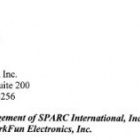SteamAtom
Member Since: June 27, 2007
Country: United States
-
Could we get a measurement on the weight and resistance of this product?
-
4pcb.com will do small quantities. Goldphoenix also now offers flex, which probably explains the arrival at Sparkfun, as I think they use GP for their PCBs.
-
I don't think the original fio did, and I would imagine they'd be saying it if so. So I have no answer to your question.
-
The data sheet seems to imply that 950nm is the wavelength of IR light to use.
-
Thank you, these are hard to find in quantity.
-
Inconvenient voltages that are at least ~1.5v HIGHER than your desired output voltage. I've been poring over the data sheet trying to integrate this into a project for a month, and the piezo basically has to output more than 5v to be usable for a 3.3v power output.
What I can't really figure out is the maximum voltage the chip can take from the piezo - the data sheet seems to imply there's a clamping diode for ~18v, but then goes to say the maximum voltage allowed on that PZ input is 20v! Is this correct?
If that's the case, then this is only useful where your piezo output can reach more than 5v, but doesn't exceed 20v. -
You should also check out the real challenge of high altitude ballooning - long duration flight - http://spiritofknoxville.com
-
Really, I've never confused the two, and I'd heard of both before. I do hope SPARC just stops that silliness.
-
Hey there,
I've made a pogo test bed to quickly reprogram a tiny board of mine! I looked at your eagle files for your pogo pin fixture bottom board, and it looked like you used 0.040 holes for the pogo pins. I did the same 0.040 holes, however, I couldn't fit the pogo pins into the holes! I had to ream the holes out to allow them to squeeze in. Is this the kind of fit you guys have with pogo pins or should it be free to slide into the solder pad hole?
My boards have parts on both sides and around the edges, so it's not so easy to use a surrounding PCB to hold the target board in place. I've simply placed holes in my target board to slide onto alignment pins soldered in the middle board.
Once I got them in, it worked great!
I'd be happy to post a pic, not sure how though.
Thanks for the great tutorials!
Dan









